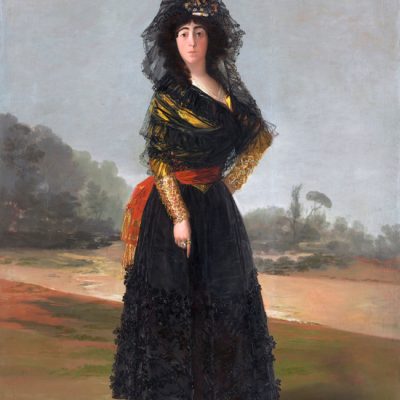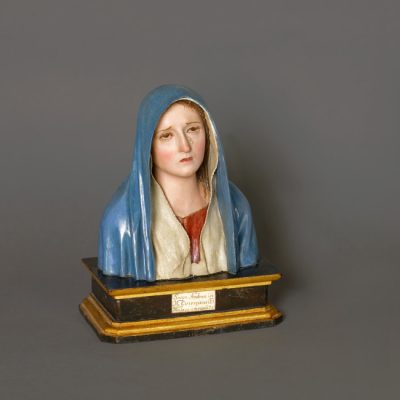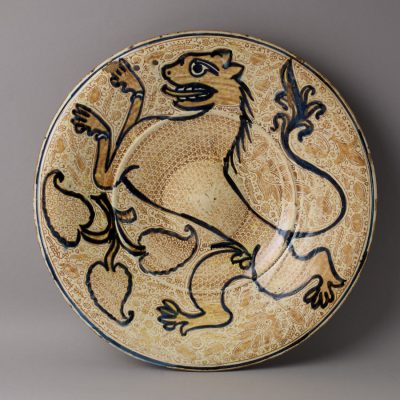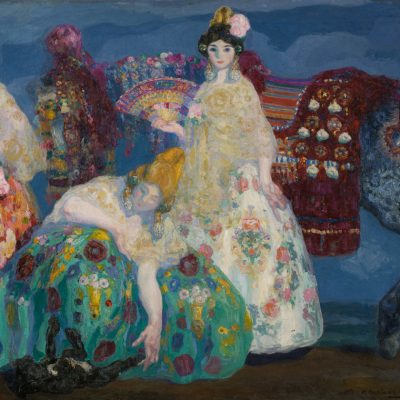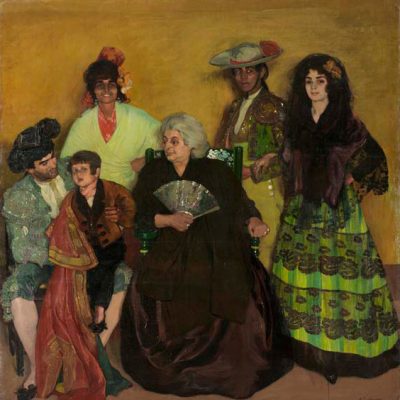
The Royal Academy of Arts is presenting Spain and the Hispanic World, an exhibition that celebrates the outstanding collection of the Hispanic Society Museum & Library in New York. This collection, presented for the first time in the UK, takes visitors on a visual journey through the history of Spanish culture, showcasing over 150 works ranging from paintings and sculptures to silk textiles, ceramics, and rare books. The collection reflects the diverse cultural and religious influences that have shaped Spanish culture over the course of four millennia, from Celtic and Islamic roots to American, African, and Asian influences.

Joaquín Sorolla, Vision of Spain (sketch) (detail), 1912-1913. Courtesy of Royal Academy
Spain and the Hispanic World: Treasures from the Hispanic Society Museum & Library
Royal Academy of Arts
21 January – 10 April 2023
The exhibition showcases works from Spain and colonial Latin America, spanning from antiquity to the early 20th century. Some highlights include masterpieces such as The Duchess of Alba (1797) by Francisco de Goya, Count-Duke of Olivares (1625-26), and Portrait of a Girl (1638-42) by Diego Velázquez. Visitors can also admire more exceptional paintings by the biggest names in Spanish art, including El Greco, Francisco de Zurbarán, Joaquín Sorolla, Ignacio Zuloaga, and José Gutiérrez Solana. By the end of the exhibition, a large-scale panoramic series of 14 paintings by Sorolla are presented for the Vision of Spain, a monumental mural painted for the Hispanic Society between 1912 and 1919.
Other unmissable pieces include sculptures, such as polychrome reliquary busts by Pedro de Mena and his daughter Andrea de Mena, as well as exceptional earthenware bowls from the Bell Beaker culture, Hispano-Islamic silk textiles, and some of the finest examples of lustreware from Manises, Valencia. The Hispanic Society’s renowned library is also on display, with highlights including a beautifully illuminated Hebrew Bible and a rare Black Book of Hours.
Spain played a significant role in the colonization of Latin America, starting with the arrival of Christopher Columbus in the Caribbean in 1492. Over the next centuries, Spain established colonies and territories throughout the region, influencing their culture, religion, and language. This period of colonization had a profound impact on the indigenous populations and the formation of a unique Latin American identity. During the 19th and early 20th centuries, most of the Latin American countries gained independence from Spain, though its influence can still be seen in the region’s language, architecture, and culture. These historical influences can be seen in the rarely seen colonial Latin American treasures displayed in this exhibition, creating a compelling parallel narrative to the cultural developments taking place across mainland Spain. Some works include the World Map by Giovanni Vespucci, the Map of Tequaltiche, decorative lacquerware from Colombia and Bolivia, and paintings such as Young Man from the Coast by José Agustín Arrieta.
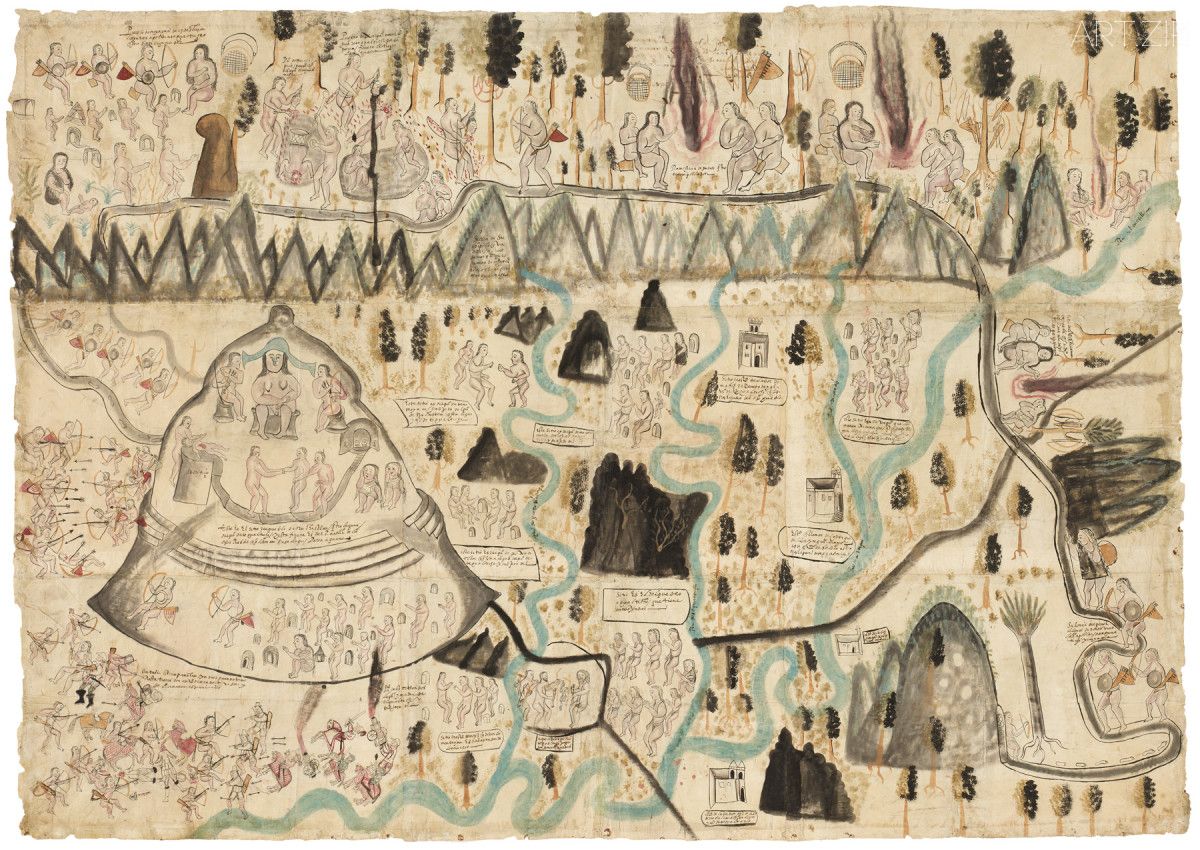
Map of Tequaltiche, 1584.
Spain and the Hispanic World offers a captivating and visual educational journey through Spanish history. A must-see exhibition for historical art lovers and Spanish culture enthusiasts, offering a rare glimpse into the rich cultural heritage of Spain and colonial Latin America. Visitors will have a unique opportunity to immerse themselves in the richness and diversity of Spanish culture.
Interview with Per Rumberg
On the preview day, we had the pleasure of speaking with Per Rumberg, the curator of the exhibition. We discussed the creative process, sources of inspiration, and the current and important discussions surrounding decolonization in the art world, which are highly relevant to today’s society.
AZ: This is the first time that the Hispanic Society Museum & Library collection being exhibited in the UK, and it showcases Spanish culture in such a diverse way. What are the driving forces and goal of this exhibition?
PR: The exhibition is attempting to do two things. It’s a visual survey. It’s a survey of visual culture in Spain throughout the centuries, but the opportunity that we had to show the collection of the Hispanic Society for the first time in this country is because the Hispanic Society is closed for refurbishment and the close in 2017 was a major renovation campaign. They’re hoping to reopen this year in March, even before this exhibition closes, but it’s been closed for five years, and the works are not on display at the moment. So, we had the opportunity to bring the works here, which are normally on display in New York only. And because the Hispanic Society is arguably the most important collection of Spanish art outside Spain, it allows us to give the survey of Spanish and Hispanic art coming from one place, we thought it was a great opportunity that we couldn’t miss.
AZ: Can you tell us about your process of selecting the artists or works that are featured in the exhibition?
PR: The first time that this collection was shown away from the Hispanic Society was when they closed in 2017 and went to the Prado. The curators from the Hispanic Society and the Prado made a selection of the highlights of the collection but also decided to make it a chronological survey. On that basis, we worked with that collection and then we tried to adapt it, we changed it slightly for what we thought was important to show here in London. We took some of the more historical documents which were shown in El Prado, which are very important, and are part of the collection. Here in London as an academy, we were focusing more on art and not only on painting, so we maintained the fact that only a third of the exhibition is actually paintings. The rest are sculptures, decorative arts, textiles, earthenware, and lustreware from colonial Latin America. We maintained that richness, but we’re focusing more strongly on the art. Then we added some works, we added a painting by Goya, and we added a sort of conclusion to the exhibition by showing that very beautiful eight-metre-long sketch by Sorolla, for the Visions of Spain, for his monumental mural that he painted for the Hispanic Society […]. We decided to frame it and show it here for the first time, which I think is a beautiful way of bringing the two strands of the exhibition back together: the survey of Spanish art and the history of the Hispanic Society […].
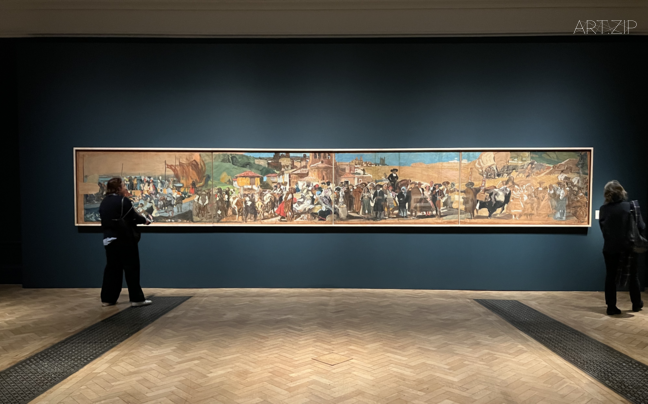
Vision of Spain, 1912-1913, by Joaquín Sorolla ©ART.ZIP
AZ: That’s great! We did feel this was like a little piece of Spain inside a museum, so the purpose of this exhibition was very much achieved!
PR: I hope so!
AZ: Given the extensive colonial history of Spain, especially in Latin America – which is also addressed in this exhibition – plus the increasing importance of the decolonisation of knowledge in the arts and cultural sector nowadays, how do you think this exhibition approaches this issue?
PR: Great question, of course. Colonialism is a very complex and very controversial question, which I hope we tried to address in our interpretation and to understand it in its complexity and to strongly condemn what happened in the Americas, and a lot of the ruthless behaviour of the conquistadores in the 16th century. But we felt it was important to represent that part of Spanish history because it changed fortunes drastically for Spain, and for centuries, these vice royalties in Latin America produce great wealth for mainland continental Spain. […] What is very beautiful is the indigenous techniques that you can very strongly see represented in this exhibition with the objects that were shown. You see how there’s the merging of traditions and cultures, and a lot of these works would then be imported into Spain, and then influences the artists working in Spain, so it’s a sort of cross-fertilisation, which enriches Spanish culture to move forward.
AZ: How do you see this exhibition fitting into a broader context of today’s society and British society?
PR: I feel that whereas the English have a great love affair with Spain, as they do with Italy, Italian art in history is much better known in this country, and much better represented in collections in this country, and Spanish art is a bit less. We hope that we address that with the exhibition and that people can learn more about Spanish art. They can go to the National Gallery and see a very beautiful and wonderful collection of Golden Age paintings by Velazquez, and Goya, but they can’t in one room follow the trajectory of the history of painting in Spain from the early 1400s onwards. Also, we can show it here together not only with other paintings but with other works of art, with the textiles, illuminated manuscripts and jewellery, and it’s important, I think, to see it in its full context.
AZ: Last but not least, apart from the mural by Sorolla mentioned earlier, are there any other highlights in the exhibition that you are excited for viewers to see?
PR: There are many highlights. I find that the bell beaker bowls which were made over 4000 years ago are extremely beautiful and the Islamic lustreware which the Spanish-speaking society has a beautiful collection of. One of my favourite paintings in the exhibition is this picture by Velazquez, a little picture of a girl, we don’t know who she is, a very intimate picture. He painted pictures of royal children, but she hasn’t been identified as one of the royal children. It’s a picture that he kept in his own studio, it’s clearly something that’s very personal to him. You can see by the way that he painted it, that he clearly had a relationship to this girl, that she was somebody known to him, and we think it may have been one of his granddaughters. That picture for me is one of the most beautiful pictures in this exhibition. But then of course, there’s the Duchess of Alba by Goya, which is the star, the most important work in the collection, which is beautiful. Then, in the colonial Latin American section, there are the ‘Four fates of man’ from Ecuador by an artist called Caspicara, which are little polychrome wooden sculptures, quite expressive and really extraordinary.
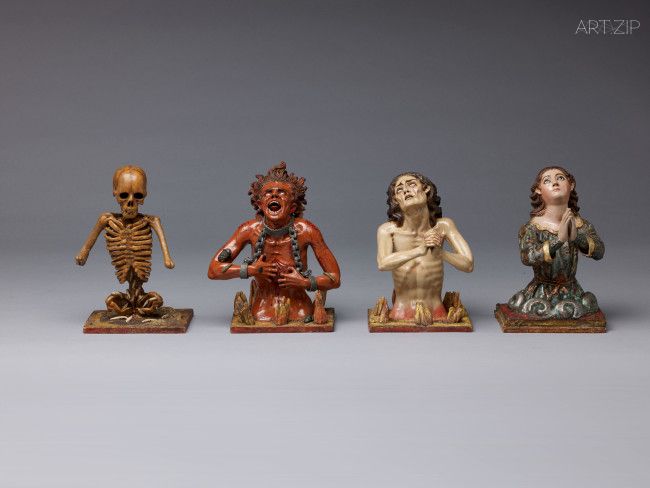
Caspicara, The Four Fates of Man- Death, Soul in Hell, Soul in Purgatory, Soul in Heaven, c. 1775.
西班牙與西班牙裔世界:來自西班牙裔社會博物館和圖書館的珍藏
皇家藝術學會
2023年1月21日至4月10日
皇家藝術學院的春季大展《西班牙與西班牙裔世界》已於一月開啟,該展覽首次在英國展出紐約西班牙社會博物館及其圖書館的珍貴收藏,帶領觀眾進行了一次西班牙文化與歷史的視覺之旅。此次展覽展示了超過150件作品,囊括繪畫、雕塑、絲綢紡織品、陶瓷和珍本書籍等,反映了西班牙四千年來受到的各種多元文化及宗教影響,當中包括凱爾特文化、伊斯蘭文化,美洲、非洲以及亞洲文化等等。
這次展覽展示了從古代到20世紀初期西班牙及其拉丁美洲殖民地的作品,一些亮點作品包括:戈雅(Francisco de Goya)的《阿爾巴公爵夫人(1797年)》,委拉斯奎茲(Diego Velázquez)的《奧利瓦雷斯伯爵公爵(1625-26)》以及《一個女孩的肖像(1638-42)》等。
此外,觀眾還可以欣賞到其他西班牙藝術大師們的傑作,包括埃爾·格列柯(El Greco)、弗朗西斯科·德·蘇爾巴蘭(Francisco de Zurbarán)、華金·索羅拉(Joaquín Sorolla)、伊格納西奧·祖洛亞(Ignacio Zuloaga)和何塞·古鐵雷斯·索蘭納(José Gutiérrez Solana)。
在展覽的最後一個展廳裡呈現的是一組由Sorolla創作的大型全景繪畫《西班牙景象(Vision of Spain)》,這是藝術家為西班牙社會博物館在1912年至1919年間創作的壯麗壁畫,長達八米。
展覽中還有許多不能錯過的作品,包括:Pedro de Mena的女兒Andrea de Mena創作的彩色聖母半身像,以及貝爾畢克文化的特殊陶碗,西班牙-伊斯蘭絲綢紡織品,以及來自馬尼塞斯、瓦倫西亞最好的金光陶瓷器皿。博物館的圖書館部門也為公眾帶來了精美且罕見的希伯來聖經以及黑色聖經。
從1492年哥倫布抵達加勒比地區開始,西班牙在拉丁美洲的殖民化進程中發揮了重要作用。在接下來的幾個世紀裡,西班牙在整個地區建立了殖民地和領土,影響了他們的文化、宗教和語言。這段殖民時期對土著居民產生了深遠的影響,並形成了獨特的拉丁美洲身份。在19世紀和20世紀初,大多數拉丁美洲國家從西班牙中獨立出來,但該地區的語言、建築和文化仍然受到西班牙的影響。這些歷史影響在本次展覽中展出的拉丁美洲殖民地珍寶中十分顯著,也為西班牙大陸發生的文化發展創造了一個引人入勝的平行敘事。其中一些難得的作品包括: Giovanni Vespucci的世界地圖、Tequaltiche地圖、來自哥倫比亞和玻利維亞的裝飾漆器,以及 José Agustín Arrieta 的 《來自海岸的年輕男子(Young Man from the Coast)》等等。

José Aguåstín Arrieta, El Costeño (The Young Man from the Coast), c. 1843.
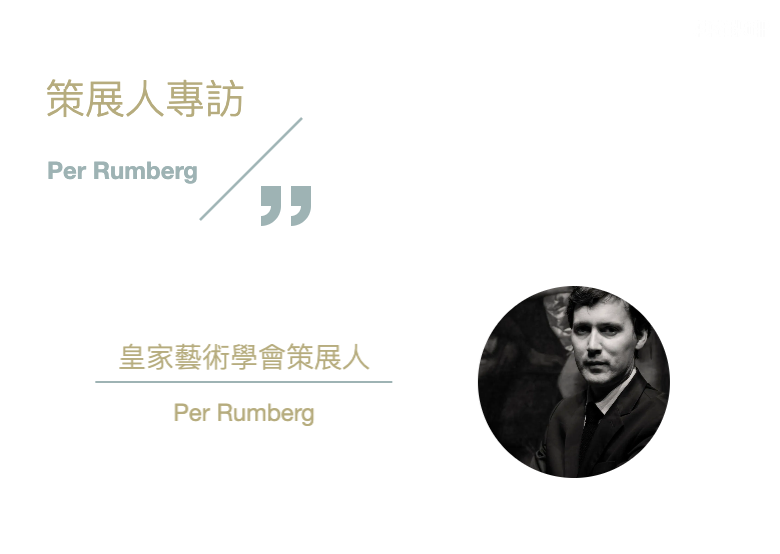
我們有幸在預展日當天與策展人Per Rumberg 就展覽的籌辦過程、靈感來源以及藝術界非殖民化的重要議題進行了討論。
AZ:這是西班牙社會博物館及其圖書館第一次在英國展出他們的藏品,這次展覽背後的動機和目的是什麼呢?
PR:這次展覽試圖進行對西班牙作一個視覺探索。這是對幾個世紀以來西班牙視覺文化的調查,我們有機會在英國首次展示西班牙裔社會的收藏是因為西班牙裔社會博物館因翻新而暫時關閉,這次關閉從2017年就開始了,那是一個的重大的改造,他們希望今年三月重新開放,甚至在這個展覽結束之前重新開放,但因為博物館已經關閉了五年,目前沒有藏品被展出過,因此我們有機會把只在紐約展出的珍藏帶到英國。西班牙裔社會博物館可以說是擁有著西班牙以外最重要的西班牙藝術收藏,因此這次能讓我們在一個地方就能看到這些珍貴的藏品,對西班牙和西班牙藝術進行歷史和藝術探索,我們認為這是一個不能錯過的絕佳機會。
AZ:你們是如何挑選展品的呢?
PR:這個系列的藏品其實在馬德里的El Prado博物館展出過,那是第一次在西班牙裔社會博物館以外的地方展出。那時候正是2017年,西班牙裔社會博物館要進行臨時閉關整修。西班牙裔社會博物館和El Prado博物館的策展人挑選了藏品裡的一些亮點作品,但那時候他們決定按時間順序來進行展示。在此基礎上,我們保留了他們原來挑選的一些藏品,然後嘗試對其進行輕微的調整,以展現我們認為在倫敦展示的重要部分。我們選擇了一些在El Prado博物館展示的歷史文件,這些文件非常重要,也是是收藏的一部分。作為一所藝術學會,我們會更多地關注藝術,不僅僅是繪畫形式。你可以看到展覽中只有三分之一是繪畫,其餘的是來自拉丁美洲殖民地的雕塑、裝飾藝術、紡織品、陶器和金光陶瓷器皿等等。我們保持了這種展品的豐富性,但我們更加關注藝術。我們還添加了一些作品,我們增添了戈雅的畫,我們還通過展示Sorolla那幅非常漂亮的八米長繪畫為展覽作了一個總結——《西班牙景象(Visions of Spain)》,這是一幅為西班牙裔社會博物館畫的不朽的壁畫。我們決定將它裝裱起來並在這裡進行首次展示,我認為這是將展覽的兩個部分重新組合在一起的絕妙方式:西班牙藝術概覽和西班牙裔社會的歷史。
AZ:這個結尾真的很棒,這次展覽確實讓人覺得是博物館裡的小小西班牙,這個展覽的目的達到了!
PR:但願如此!
AZ:西班牙在拉丁美洲的殖民歷史在本次展覽中佔據了相當重要的部分,而當今藝術和文化領域圍繞非殖民化的課題重要性也日益增加,這次展覽是如何處理這個問題的?
PR:這是個好問題。殖民主義是一個非常複雜和非常有爭議的問題,我希望在我們的解讀中解決這個問題,理解它的複雜性,並強烈譴責美洲發生的事情,以及16世紀征服者的許多無情行為。但我們認為展示西班牙歷史的那一部分很重要,因為它徹底改變了西班牙的命運,幾個世紀以來,拉丁美洲的這些副皇室成員為西班牙大陸創造了巨大的財富。當地的那些藝術非常迷人,大家可以在本次展覽中看到這些藝術技巧的運用。你會看到當地傳統和外來文化是如何融合的,許多殖民地的作品被引入到西班牙,然後影響在西班牙工作的藝術家。所以這是一種交叉施肥,豐富了西班牙文化並推動它向前發展。
AZ:您覺得這個展覽是怎樣與當今社會和英國社會結合起來的?
PR:我覺得雖然英國人對西班牙有著濃厚的感情,就像他們對意大利一樣,但意大利歷史上的藝術在這個國家更為人所知,並且在這個國家的收藏中表現得更好,而西班牙藝術相對較少。我們希望通過這次展覽解決這個問題,讓人們可以更多地了解西班牙藝術。大家可以去國家美術館,欣賞委拉斯奎茲(Velazquez)和戈雅(Goya)黃金時代的精彩收藏,但卻沒有機會在一個屋簷下追尋1400年代以來西班牙繪畫史的軌跡。此外,我們在這裡不僅可以將它與其他繪畫一起展示,還可以將它與其他藝術作品、紡織品、彩繪手稿和珠寶一起展示。我認為,重要的是要在完整的背景下看待它。
AZ:除了前面提到的Sorolla的壁畫,展覽中還有哪些作品你覺得可以重點觀看的嗎?
PR:這個展覽上有很多亮點作品。我覺得4000多年前製作的鐘形燒杯非常漂亮,還有西班牙裔社會博物館收藏的伊斯蘭金光陶瓷器。個人來說,展覽中我最喜歡的作品是委拉斯奎茲(Velazquez)的一幅小小的油畫,那是一張小女孩的畫像,我們不知道她是誰,但顯然是很親密的圖像。委拉斯奎茲畫了許多皇室子女的畫像,但這幅畫裡的小女孩並沒有被確認是皇室後代。藝術家本人將這幅畫收藏在自己的工作室裡,這顯然對他來說是非常私人和珍愛的東西。從他畫的方式可以看出,他和這個女孩有重要的關係,她是委拉斯奎茲認識的人,我們覺得這很可能是他的孫女。那幅作品對我來說是這次展覽中最美的作品之一。
但當然,還有戈雅的《阿爾巴公爵夫人》,是該系列中最重要的作品,非常漂亮。在殖民地拉丁美洲部分,有來自厄瓜多爾的藝術家Caspicara創作的《人類的四種命運》,這些彩色小木雕非常富有表現力,非常特別。
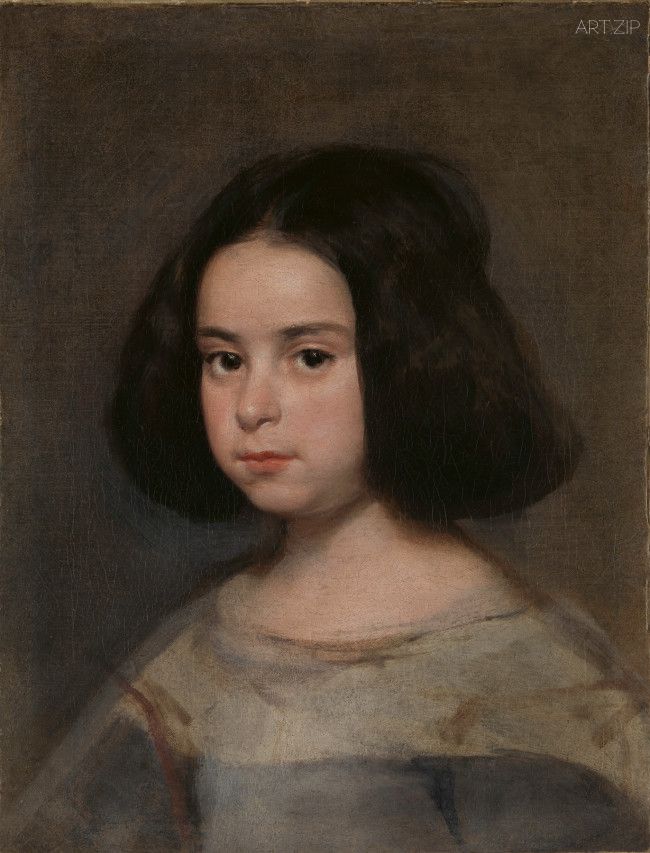
Diego Velázquez, Portrait of a Girl, c. 1638-42
《西班牙與西班牙裔世界》無疑為倫敦的觀眾提供了迷人的西班牙歷史及視覺教育之旅,使其在倫敦就能一睹西班牙及其拉丁美洲殖民地豐富的文化遺產。美術館裡的小小西班牙,你去看了嗎?
Interviewed and Edited by 採訪與编辑 x Victoria Huang 黄婧

